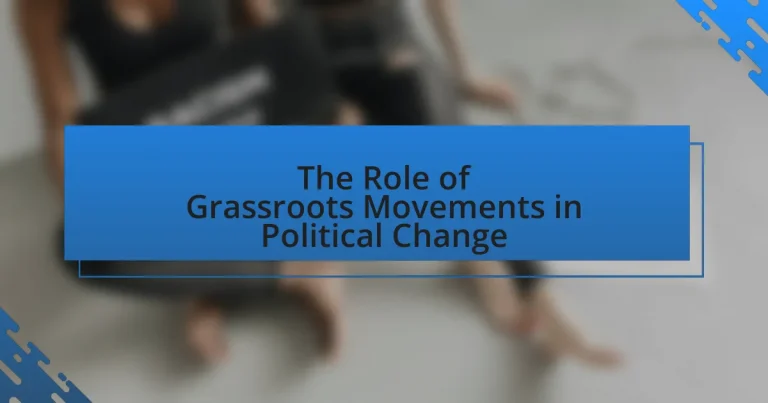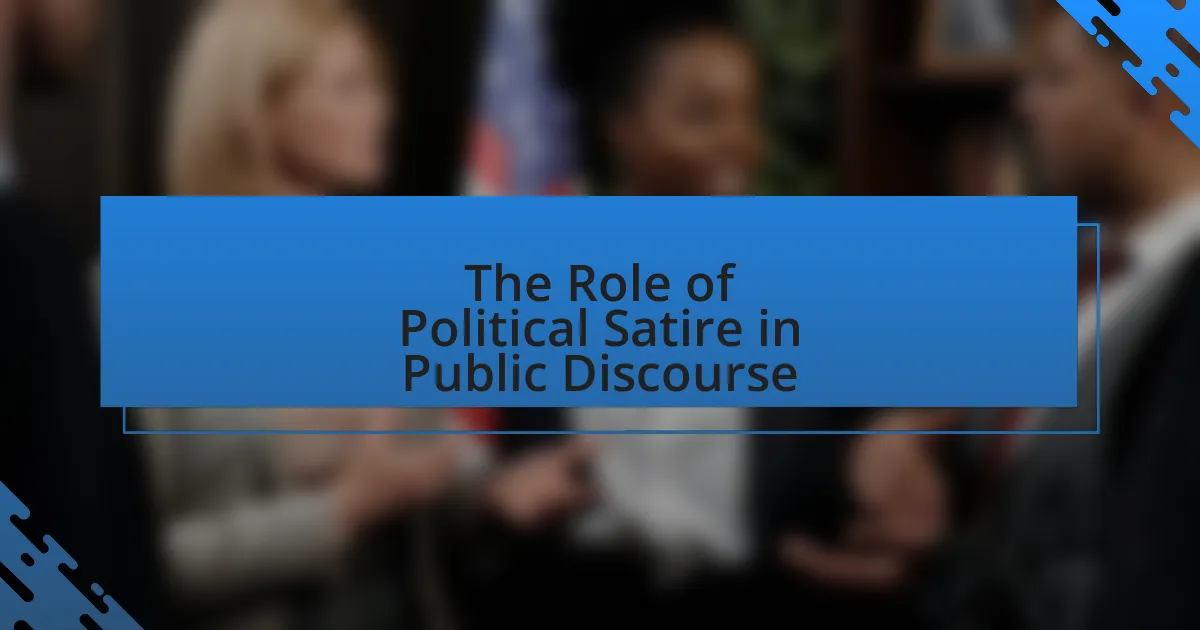Grassroots movements are collective actions initiated by ordinary individuals at the community level aimed at achieving social or political change. This article explores the significance of grassroots movements in driving political change, highlighting their ability to empower marginalized voices, mobilize public opinion, and influence policy decisions. Key historical examples, such as the Civil Rights Movement in the United States and the Arab Spring, illustrate how grassroots activism can lead to substantial political transformations. The article also examines the characteristics that define grassroots movements, the strategies they employ, the challenges they face, and the best practices for enhancing their effectiveness in advocating for change.
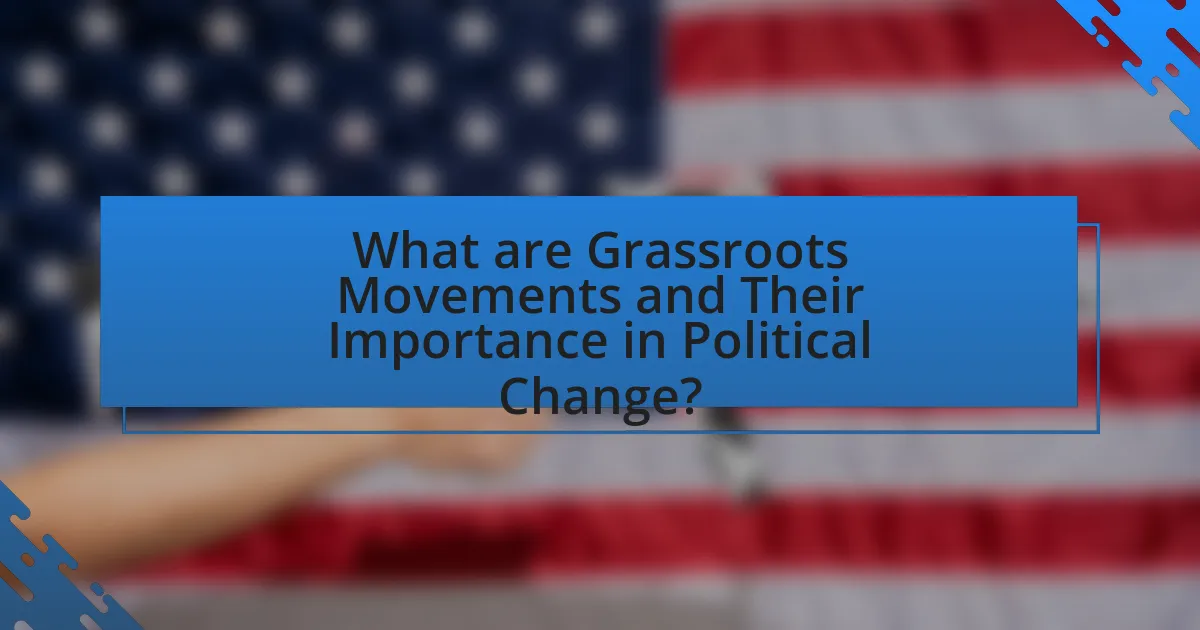
What are Grassroots Movements and Their Importance in Political Change?
Grassroots movements are collective actions initiated by ordinary people at the community level to effect social or political change. These movements are crucial in political change as they empower marginalized voices, mobilize public opinion, and influence policy decisions. For instance, the Civil Rights Movement in the United States, which began with grassroots organizing, led to significant legislative changes such as the Civil Rights Act of 1964. This demonstrates that grassroots movements can effectively challenge established power structures and drive systemic change through community engagement and activism.
How do Grassroots Movements differ from Traditional Political Movements?
Grassroots movements differ from traditional political movements primarily in their structure and approach to mobilization. Grassroots movements are typically initiated and sustained by ordinary citizens at the community level, focusing on local issues and relying on collective action, whereas traditional political movements often involve established political parties or organizations that operate within formal political systems and hierarchies.
For example, grassroots movements like the Civil Rights Movement in the United States emerged from community-led efforts to address systemic injustices, while traditional political movements, such as the Democratic Party, operate through established electoral processes and institutional frameworks. This distinction highlights how grassroots movements prioritize direct participation and community engagement, often leading to rapid mobilization and adaptability in response to social issues.
What characteristics define Grassroots Movements?
Grassroots movements are characterized by their community-driven nature, where ordinary individuals mobilize to advocate for social or political change. These movements typically emerge from local communities and prioritize collective action, emphasizing participation and engagement from a broad base of supporters. They often rely on informal networks and grassroots organizing strategies, such as door-to-door campaigning and social media outreach, to raise awareness and build momentum. Historical examples, such as the Civil Rights Movement in the United States, illustrate how grassroots efforts can lead to significant political and social transformations, demonstrating the effectiveness of localized activism in influencing policy and public opinion.
Why are Grassroots Movements considered vital for democracy?
Grassroots movements are considered vital for democracy because they empower ordinary citizens to participate actively in the political process. These movements facilitate collective action, enabling individuals to voice their concerns and influence policy decisions. Historical examples, such as the Civil Rights Movement in the United States, demonstrate how grassroots activism can lead to significant legislative changes, like the Voting Rights Act of 1965, which expanded voting access and protected civil rights. By mobilizing communities and fostering civic engagement, grassroots movements enhance democratic accountability and ensure that diverse perspectives are represented in governance.
What historical examples illustrate the impact of Grassroots Movements?
Grassroots movements have significantly impacted political change throughout history, with notable examples including the Civil Rights Movement in the United States and the anti-apartheid movement in South Africa. The Civil Rights Movement, which gained momentum in the 1950s and 1960s, mobilized ordinary citizens to challenge racial segregation and discrimination, leading to landmark legislation such as the Civil Rights Act of 1964 and the Voting Rights Act of 1965. Similarly, the anti-apartheid movement in South Africa, driven by grassroots activism, played a crucial role in dismantling the apartheid regime, culminating in the election of Nelson Mandela in 1994. Both movements exemplify how grassroots efforts can lead to substantial political and social transformations.
How did the Civil Rights Movement exemplify Grassroots activism?
The Civil Rights Movement exemplified grassroots activism through its reliance on local communities to mobilize for social change. Activists organized protests, sit-ins, and voter registration drives, often led by individuals from within the affected communities, such as the Montgomery Bus Boycott initiated by Rosa Parks and the subsequent leadership of Martin Luther King Jr. This movement demonstrated the power of collective action, as seen in the 1963 March on Washington, where over 250,000 people gathered to demand civil rights, showcasing the effectiveness of grassroots organizing in influencing national policy. The success of the Civil Rights Act of 1964 and the Voting Rights Act of 1965 can be directly linked to the sustained efforts of grassroots activists who engaged everyday citizens in the fight for equality.
What role did Grassroots Movements play in the Arab Spring?
Grassroots movements were pivotal in the Arab Spring, serving as the primary catalysts for widespread protests and demands for political reform across the region. These movements mobilized citizens through social media and community organizing, effectively challenging authoritarian regimes. For instance, in Tunisia, the grassroots movement initiated by the self-immolation of Mohamed Bouazizi sparked nationwide protests that led to the ousting of President Zine El Abidine Ben Ali in January 2011. Similarly, in Egypt, grassroots organizations like the April 6 Youth Movement played a crucial role in coordinating protests that culminated in the resignation of President Hosni Mubarak in February 2011. The collective action and solidarity fostered by these grassroots movements demonstrated the power of ordinary citizens in demanding change, ultimately reshaping the political landscape in several Arab countries.
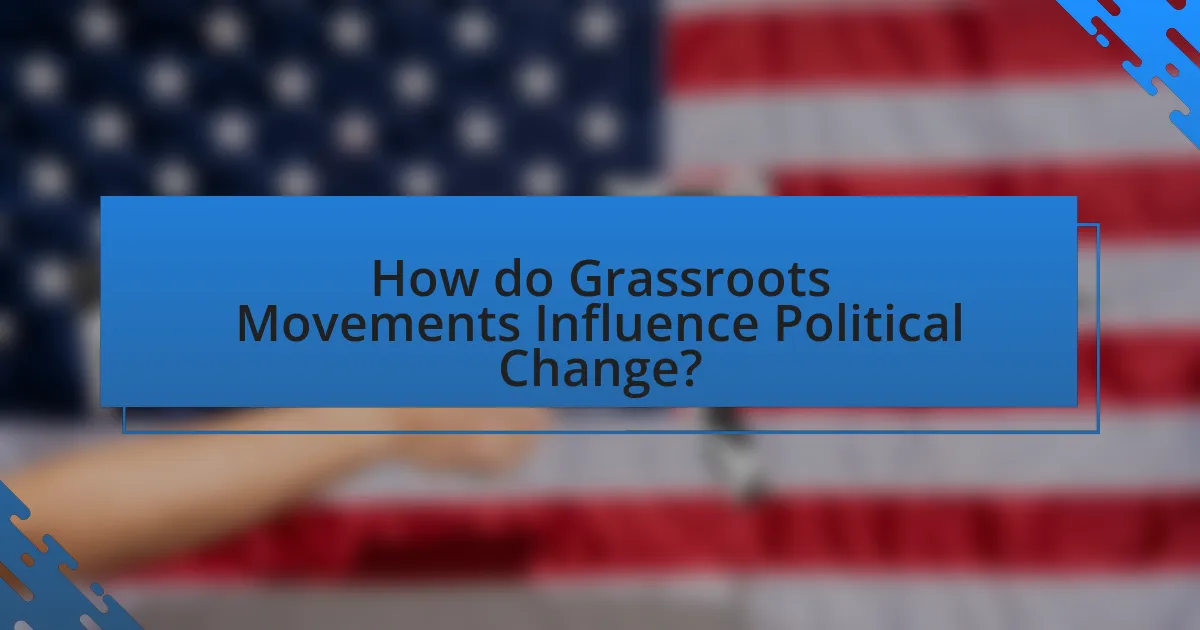
How do Grassroots Movements Influence Political Change?
Grassroots movements influence political change by mobilizing community members to advocate for specific issues, thereby creating pressure on political leaders and institutions. These movements often utilize strategies such as organizing protests, engaging in voter registration drives, and leveraging social media to amplify their messages. For instance, the Civil Rights Movement in the United States effectively utilized grassroots organizing to challenge segregation laws, leading to significant legislative changes like the Civil Rights Act of 1964. Additionally, research indicates that grassroots movements can shift public opinion, as seen in the environmental movement, which has raised awareness about climate change and influenced policy decisions globally.
What strategies do Grassroots Movements employ to effect change?
Grassroots movements employ strategies such as community organizing, advocacy, and coalition-building to effect change. Community organizing involves mobilizing individuals at the local level to address specific issues, fostering a sense of collective identity and empowerment. Advocacy efforts focus on influencing policymakers and public opinion through campaigns, lobbying, and public demonstrations, as seen in movements like the Civil Rights Movement, which utilized protests to push for legislative change. Coalition-building brings together diverse groups to amplify voices and resources, enhancing the movement’s impact, exemplified by the Women’s March, which united various organizations to advocate for women’s rights. These strategies are effective as they leverage local knowledge, foster solidarity, and create pressure for systemic change.
How do social media and technology enhance Grassroots organizing?
Social media and technology enhance grassroots organizing by facilitating rapid communication, mobilization, and community engagement. These platforms allow grassroots movements to disseminate information quickly, reaching a wider audience than traditional methods. For instance, during the Arab Spring, social media played a crucial role in organizing protests and sharing real-time updates, which significantly contributed to the movements’ momentum. Additionally, technology enables the use of data analytics to identify and target specific demographics, improving outreach effectiveness. Research from the Pew Research Center indicates that 69% of adults in the U.S. use social media, highlighting its potential as a powerful tool for grassroots organizers to connect and mobilize supporters efficiently.
What role does community engagement play in Grassroots Movements?
Community engagement is essential in grassroots movements as it fosters collective action and mobilizes individuals towards a common goal. By involving community members, grassroots movements can effectively identify local issues, build trust, and create a sense of ownership among participants. For instance, the Civil Rights Movement in the United States relied heavily on community engagement to organize protests and raise awareness about racial injustice, leading to significant legislative changes such as the Civil Rights Act of 1964. This demonstrates that active participation not only amplifies voices but also drives political change through organized efforts.
Why are Grassroots Movements effective in mobilizing public support?
Grassroots movements are effective in mobilizing public support because they leverage community engagement and personal connections to inspire collective action. These movements often arise from local issues that resonate deeply with individuals, fostering a sense of ownership and urgency. For instance, the Civil Rights Movement in the United States successfully mobilized public support through grassroots organizing, leading to significant legislative changes like the Civil Rights Act of 1964. This effectiveness is further evidenced by the ability of grassroots movements to utilize social media platforms, which amplify their reach and facilitate rapid information dissemination, as seen in the Arab Spring. Such movements create a powerful narrative that resonates with the public, encouraging participation and solidarity, ultimately driving political change.
How do personal stories and narratives drive Grassroots campaigns?
Personal stories and narratives drive grassroots campaigns by creating emotional connections that mobilize individuals and foster community engagement. These narratives humanize issues, making them relatable and compelling, which can inspire action and solidarity among supporters. For instance, campaigns like the “Me Too” movement utilized personal testimonies to highlight the prevalence of sexual harassment, effectively galvanizing public support and prompting legislative discussions. Research indicates that emotionally resonant stories can increase empathy and motivate individuals to participate in activism, as evidenced by studies showing that narratives can significantly enhance message retention and influence attitudes toward social issues.
What psychological factors contribute to the success of Grassroots Movements?
Psychological factors that contribute to the success of grassroots movements include collective identity, social cohesion, and perceived efficacy. Collective identity fosters a sense of belonging among participants, which strengthens commitment and motivation. Social cohesion enhances trust and collaboration within the group, facilitating coordinated actions. Perceived efficacy, the belief that collective efforts can lead to meaningful change, drives engagement and persistence. Research indicates that movements with strong collective identities and high perceived efficacy are more likely to achieve their goals, as seen in the Civil Rights Movement, where shared identity and belief in the power of collective action were pivotal to its successes.
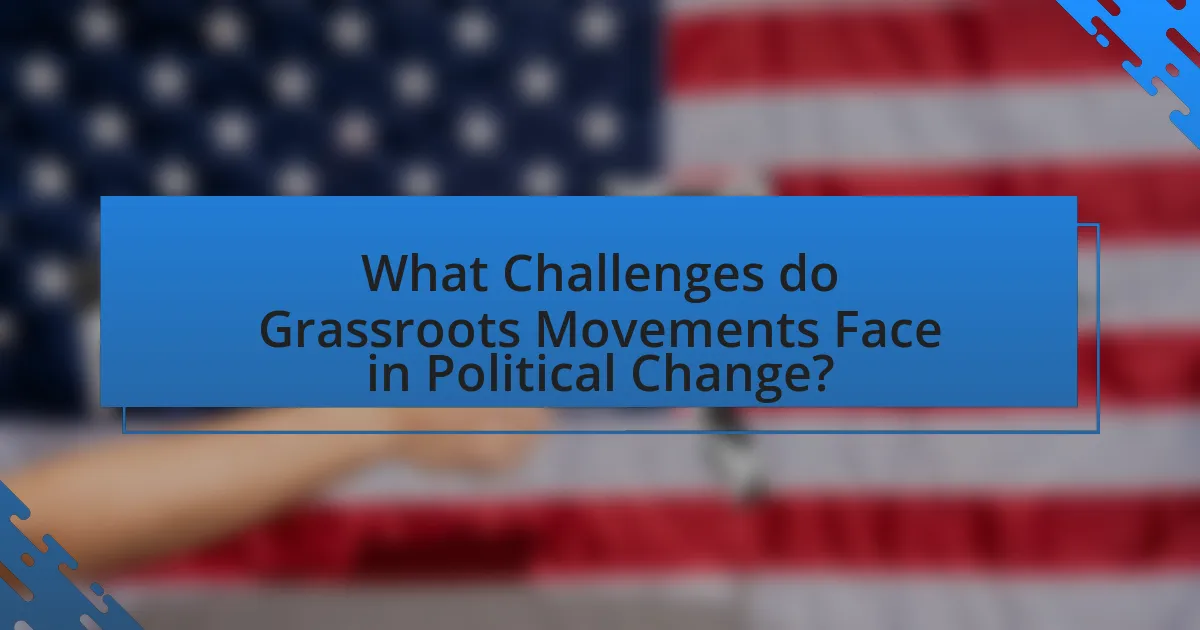
What Challenges do Grassroots Movements Face in Political Change?
Grassroots movements face significant challenges in achieving political change, primarily due to limited resources, institutional resistance, and fragmentation within their ranks. Limited financial and human resources hinder their ability to mobilize effectively and sustain campaigns, as evidenced by studies showing that well-funded organizations often dominate political discourse. Institutional resistance manifests through legal barriers, political pushback, and co-optation by established political entities, which can dilute the original goals of grassroots initiatives. Additionally, fragmentation occurs when differing ideologies and strategies among grassroots groups lead to disunity, weakening their collective impact. These challenges collectively impede the ability of grassroots movements to influence policy and effectuate meaningful change in the political landscape.
What obstacles hinder the effectiveness of Grassroots Movements?
Grassroots movements face several obstacles that hinder their effectiveness, including lack of funding, organizational challenges, and resistance from established power structures. Limited financial resources restrict their ability to mobilize supporters and sustain campaigns, as evidenced by studies showing that movements with greater funding often achieve more significant impact. Organizational challenges, such as coordination among diverse groups and maintaining a unified message, can dilute efforts and confuse potential supporters. Additionally, established political entities often resist grassroots initiatives, employing tactics such as disinformation campaigns or legal barriers to undermine their influence, which has been documented in various case studies of social movements.
How do funding and resource limitations impact Grassroots efforts?
Funding and resource limitations significantly hinder grassroots efforts by restricting their ability to mobilize, organize, and sustain campaigns. Without adequate financial support, grassroots movements struggle to cover essential costs such as outreach, materials, and event logistics, which are crucial for building community engagement and awareness. For instance, a study by the National Committee for Responsive Philanthropy found that organizations with limited funding often face challenges in reaching broader audiences, resulting in decreased visibility and impact. Additionally, resource constraints can lead to burnout among volunteers and organizers, as they may be overburdened with responsibilities without sufficient support. This cycle of underfunding ultimately diminishes the effectiveness of grassroots movements in driving political change and advocating for social issues.
What role does political opposition play in challenging Grassroots Movements?
Political opposition plays a significant role in challenging grassroots movements by mobilizing resources, framing narratives, and leveraging institutional power to undermine their objectives. Political opposition often seeks to discredit grassroots movements by portraying them as radical or unrepresentative of mainstream values, which can diminish public support. For instance, during the civil rights movement in the United States, political opposition utilized media campaigns to depict activists as extremists, thereby attempting to delegitimize their demands for equality. Additionally, political entities may enact legislation or use law enforcement to suppress grassroots activities, as seen in various protests where authorities have imposed restrictions on demonstrations. This multifaceted approach by political opposition can significantly hinder the effectiveness and reach of grassroots movements, impacting their ability to effect change.
How can Grassroots Movements overcome these challenges?
Grassroots movements can overcome challenges by building strong community networks and leveraging social media for mobilization. These networks foster collaboration and resource sharing, which enhances resilience against opposition. For instance, the Black Lives Matter movement effectively utilized social media platforms to organize protests and raise awareness, demonstrating the power of digital communication in overcoming barriers. Additionally, grassroots movements can engage in strategic partnerships with established organizations to amplify their reach and influence, as seen in various environmental movements that have successfully aligned with larger NGOs to push for policy changes.
What strategies can be employed to secure funding and resources?
To secure funding and resources, grassroots movements can employ strategies such as building strong community networks, leveraging social media for crowdfunding, and establishing partnerships with local businesses and organizations. Strong community networks enhance trust and engagement, which can lead to increased donations and volunteer support. For instance, a study by the Stanford Social Innovation Review found that grassroots organizations that actively engage their communities can increase funding by up to 50%. Utilizing social media platforms allows movements to reach a wider audience, facilitating crowdfunding campaigns that can generate significant financial support. Additionally, partnerships with local businesses can provide both financial resources and in-kind support, creating a mutually beneficial relationship that strengthens the movement’s impact.
How can Grassroots Movements build coalitions to strengthen their impact?
Grassroots movements can build coalitions to strengthen their impact by identifying shared goals and values with other organizations and communities. By collaborating with like-minded groups, grassroots movements can pool resources, share knowledge, and amplify their collective voice, which enhances their ability to influence policy and public opinion. For instance, the Civil Rights Movement in the United States successfully formed coalitions with labor unions, religious organizations, and student groups, which significantly increased their reach and effectiveness in advocating for social change. This collaborative approach not only broadens the base of support but also fosters solidarity, making it more challenging for opponents to dismiss their demands.
What are best practices for successful Grassroots Movements?
Successful grassroots movements prioritize community engagement, clear messaging, and strategic organization. Engaging the community fosters a sense of ownership and commitment, which is essential for mobilization. Clear messaging ensures that the movement’s goals are easily understood and resonate with a broad audience, increasing support and participation. Strategic organization involves planning actions, building coalitions, and utilizing social media effectively to amplify the movement’s reach.
For instance, the Civil Rights Movement in the United States successfully employed these practices by organizing local chapters, creating compelling narratives around equality, and leveraging media coverage to gain national attention. This approach led to significant legislative changes, demonstrating the effectiveness of these best practices in achieving political change.
How can effective communication strategies enhance Grassroots efforts?
Effective communication strategies enhance grassroots efforts by fostering community engagement and mobilizing support for social change. Clear messaging allows grassroots organizations to articulate their goals, build trust, and create a sense of belonging among participants. For instance, studies show that campaigns utilizing social media effectively can increase participation rates by up to 50%, demonstrating the power of targeted communication in reaching wider audiences. Additionally, effective communication helps in coordinating actions, sharing resources, and amplifying voices, which are crucial for sustaining momentum in grassroots movements.
What role does leadership play in the success of Grassroots Movements?
Leadership is crucial for the success of grassroots movements as it provides direction, motivation, and organization. Effective leaders mobilize community members, articulate shared goals, and foster a sense of unity, which is essential for collective action. For instance, leaders like Martin Luther King Jr. during the Civil Rights Movement effectively galvanized support and maintained focus on key objectives, leading to significant legislative changes such as the Civil Rights Act of 1964. This demonstrates that strong leadership not only inspires participation but also strategically navigates challenges, ultimately enhancing the movement’s impact on political change.
